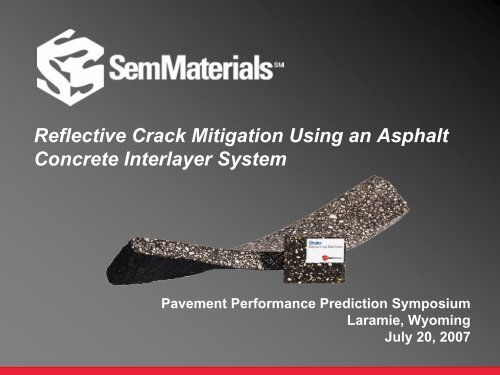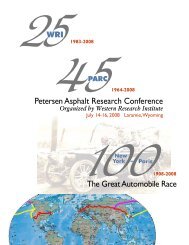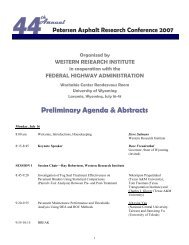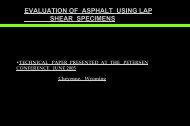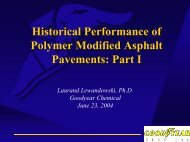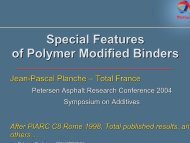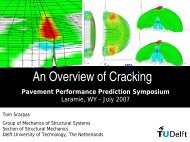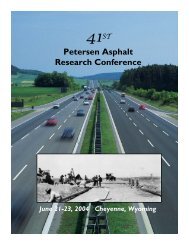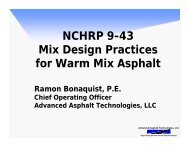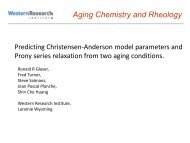Strata Reflective Crack Relief System - Petersen Asphalt Research ...
Strata Reflective Crack Relief System - Petersen Asphalt Research ...
Strata Reflective Crack Relief System - Petersen Asphalt Research ...
Create successful ePaper yourself
Turn your PDF publications into a flip-book with our unique Google optimized e-Paper software.
<strong>Reflective</strong> <strong>Crack</strong> Mitigation Using an <strong>Asphalt</strong><br />
Concrete Interlayer <strong>System</strong><br />
Pavement Performance Prediction Symposium<br />
Laramie, Wyoming<br />
July 20, 2007
Topics<br />
What?<br />
The Problem<br />
The Solution: <strong>Reflective</strong> <strong>Crack</strong> <strong>Relief</strong> <strong>System</strong><br />
Specifications<br />
Why?<br />
Advantages<br />
Project Results<br />
The Future?
What? The Problem<br />
Before<br />
Conventional HMA overlay<br />
6 months later
What? The Problem<br />
<br />
<br />
<br />
<br />
<br />
<br />
Superpave didn’t address reflective<br />
cracking<br />
Many miles of pavement in poor<br />
condition<br />
Conventional HMA overlays not<br />
addressing need<br />
NCHRP 1-41: Models for Predicting<br />
<strong>Reflective</strong> <strong>Crack</strong>ing in HMA Overlays<br />
(Texas A & M)<br />
Project 05-04 AAPTP: Techniques<br />
for Mitigation of <strong>Reflective</strong> <strong>Crack</strong>ing<br />
on HMA Airfield Pavements<br />
TPF-5(146): Evaluation of Modified<br />
Performance Grade Binders in Thin<br />
Lift Maintenance Mixes, Surface Mix<br />
and a <strong>Reflective</strong> <strong>Crack</strong> <strong>Relief</strong> Layer<br />
Mix
Core from a 3 Year Old<br />
Overlay Over PCC<br />
(New Jersey Rt. 10)<br />
Path for water intrusion to base<br />
HMA Overlay<br />
cracked through<br />
to PCC joint
The Solution<br />
<strong>Reflective</strong> <strong>Crack</strong> <strong>Relief</strong> <strong>System</strong><br />
Significantly delays reflective cracking<br />
Improving surface<br />
Protecting base<br />
Impermeable<br />
Protects pavement from moisture damage<br />
Lengthens service life<br />
Recyclable
The Solution<br />
<strong>Reflective</strong> <strong>Crack</strong> <strong>Relief</strong> <strong>System</strong><br />
Control HMA<br />
overlay<br />
Interlayer<br />
section<br />
Before<br />
The<br />
crack<br />
stops<br />
here!<br />
After
A Little History. . .<br />
1995 - First trial in U.S.<br />
1998-99 - Climatic trials in IA, IL, MO, & TX<br />
1999 - Developed performance-based bending<br />
spec on mix for consistency<br />
2000 - Placed performance-based projects in KS,<br />
KY, & MO<br />
>2001 - Process adapted for state specs &<br />
spread throughout U.S.
States with <strong>Reflective</strong> <strong>Crack</strong><br />
<strong>Relief</strong> Interlayer <strong>System</strong><br />
Through 2006:<br />
585 lane-miles (4.0 million yd 2 ) in 20 states
The Solution<br />
<strong>Reflective</strong> <strong>Crack</strong> <strong>Relief</strong> <strong>System</strong><br />
Interlayer<br />
Thin (1”) fine<br />
aggregate HMA<br />
Highly elastic PMAC<br />
<strong>Asphalt</strong>-rich,<br />
impermeable<br />
Overlay<br />
Recommendation<br />
SBS modified SHRP+<br />
spec, 98% reliability<br />
Minimum thickness to<br />
protect interlayer<br />
Overlay<br />
Interlayer<br />
Existing PCC
The Solution<br />
<strong>Reflective</strong> <strong>Crack</strong> <strong>Relief</strong> <strong>System</strong><br />
Minimum Overlay Thickness Recommendations<br />
20 yr traffic<br />
30 million ESALs = 3.5”<br />
Overlay<br />
Interlayer<br />
Thinner overlays<br />
possible with<br />
high stability<br />
interlayer option<br />
Existing PCC
Pavement Design<br />
Information<br />
Structural value<br />
Interlayer<br />
Typical HMA<br />
Dense Mix<br />
Structural Coefficient 0.20 0.35-0.44<br />
Flexural Modulus @ 20°C, psi 200,000 400,000<br />
Resilient Modulus @ 20°C, psi 493,000 740,000
Dynamic Modulus<br />
(Test Temp.=21.1 o C)<br />
Dynamic Modulus, E* Comparison of<br />
Interlayer and Typical HMA Dense Mix<br />
1,600,000<br />
Dynamic Modulus, E* (psi)<br />
1,400,000<br />
1,200,000<br />
1,000,000<br />
800,000<br />
600,000<br />
400,000<br />
200,000<br />
0<br />
0.1 10<br />
Test Frequency (Hz)<br />
Interlayer (psi)<br />
Typical HMA Dense Mix (psi)
Fracture Energy<br />
(Test Temp.=-20.0 o C)<br />
7<br />
6<br />
9.5mm PG64-22<br />
Interlayer<br />
5<br />
Load (kN)<br />
4<br />
3<br />
2<br />
1<br />
0<br />
0 1 2 3 4 5 6<br />
CMOD (mm)
Protects Pavement Base<br />
from Moisture Damage<br />
Permeability Tests on Field Samples<br />
1.E+02<br />
1.E+01<br />
Permeability<br />
(K) cm/sec<br />
1.E+00<br />
1.E-01<br />
1.E-02<br />
1.E-03<br />
1.E-04<br />
1.E-05<br />
1.E-06<br />
1.E-07<br />
1.E-08<br />
1.E-09<br />
Interlayer<br />
& Overlay<br />
Fabric &<br />
Overlay<br />
HMA<br />
Clean<br />
Sands<br />
Gravel<br />
ASTM D 5084, Standard Test Method for Measurement of<br />
Saturated Porous Materials using a Flexible Wall Permeameter.
Surface <strong>Crack</strong>ed, Interlayer Intact<br />
Impermeable Interlayer Protects Pavement<br />
PCC Joint<br />
Core after 3.5 years
Why Isn’t the Reflection<br />
<strong>Crack</strong> Over the Joint?<br />
Stress<br />
distributed over<br />
larger area<br />
<strong>Crack</strong> forms at<br />
weakest point in<br />
overlay<br />
Stress<br />
concentrated<br />
at crack / joint<br />
Overlay<br />
nterlayer<br />
PCC<br />
Joint<br />
Overlay<br />
PCC<br />
Joint<br />
<strong>Reflective</strong> <strong>Crack</strong><br />
<strong>Relief</strong> Interlayer<br />
<strong>System</strong><br />
Typical Overlay
What Does That<br />
Mean for Performance?<br />
Interlayer <strong>System</strong><br />
Overlay<br />
Interlayer<br />
PCC<br />
joint<br />
CRACK OFFSET<br />
Ride is better, structure is<br />
intact<br />
Simple Overlay<br />
joint<br />
Overlay<br />
PCC<br />
CRACKED THROUGH TO BASE<br />
Ride is worse, structure is<br />
compromised
Core Analyses<br />
61 Interlayer cores at overlay cracks<br />
Interlayer<br />
Section<br />
51 not cracked through the interlayer<br />
10 cracked into interlayer<br />
Over undoweled patches / failing<br />
joints<br />
41 cracks offset; others not checked<br />
No path for water intrusion<br />
16 HMA cores at overlay cracks<br />
15 cracked through to PCC joint<br />
Direct path for water intrusion<br />
Control<br />
Section<br />
Cores from MO, WI, TX, KS, NJ, IL & IA projects
Interlayer Specifications<br />
Materials<br />
Liquid AC Binder<br />
Minimum PG<br />
Elastic recovery<br />
Separation<br />
Fine aggregate<br />
Sand equivalency =45+<br />
Crushed & natural sands<br />
Gradation:<br />
Sieve % Passing<br />
3/8 inch (9.5 mm) 100<br />
No. 4 (4.75 mm) 80 – 100<br />
No. 8 (2.36 mm) 60 – 85<br />
No. 16 (1.18 mm) 40 – 70<br />
No. 30 (600 μm) 25 – 55<br />
No. 50 (300 μm) 15 – 35<br />
No. 100 (150 μm) 8 – 20<br />
No. 200 (75 μm) 6 –14
Design Specifications<br />
Volumetrics<br />
Mix Design Comparison<br />
Typical interlayer<br />
mix specs<br />
SGC design<br />
(Superpave Gyratory Compactor)<br />
Superpave<br />
mix specs<br />
SGC design<br />
(Superpave Gyratory Compactor)<br />
50 gyrations *100 gyrations<br />
0.5 – 2.5% air voids 4% air voids<br />
16% min VMA *15% min VMA<br />
*Criteria for 9.5mm mixture, medium traffic.
Design Specifications<br />
Performance Based Specs: <strong>Reflective</strong><br />
<strong>Crack</strong> Resistance<br />
Flexural Beam Fatigue Device,<br />
AASHTO T-321<br />
Tests mix’s ability to withstand<br />
repeated bending<br />
Data = number of loading cycles<br />
to failure (loss of strength)<br />
Run at 10x typical strain<br />
(deformation) to simulate<br />
reflective cracking caused by<br />
PCC joint movement
Performance Based Specification<br />
Highly <strong>Crack</strong> Resistant<br />
Interlayer<br />
Specification<br />
100,000<br />
PG 76-28 HMA<br />
(PMAC)<br />
PG 64-22 HMA<br />
6,000<br />
2,000<br />
0 20,000 40,000 60,000 80,000 100,000 120,000<br />
Cycles to Failure at 2000 microstrain<br />
AASHTO T-321, at test temperature<br />
Test temperature determined by project climate
Design Specifications<br />
Performance Based Specs: Hveem Stability<br />
Resistance to rutting<br />
during construction<br />
18.0 minimum Hveem<br />
stability<br />
Alternative:<br />
maximum 10 mm rut<br />
depth using <strong>Asphalt</strong><br />
Pavement Analyzer<br />
(APA)<br />
AASHTO T-246
High Stability Interlayer<br />
Designed for<br />
Thinner overlays<br />
Highly loaded pavements<br />
and thickness restrictions<br />
City streets with curb &<br />
gutter restrictions<br />
Airports<br />
Higher stability specification<br />
Stronger aggregate<br />
structure<br />
Increased rut resistance<br />
Same fatigue resistance<br />
High stability Interlayer<br />
Rock County Airport, WI<br />
Interlayer<br />
High<br />
Stability<br />
Interlayer<br />
Hveem Stability 18+ 28+<br />
Design Traffic Loading,<br />
ESALs<br />
Overlay Thickness<br />
Recommendations<br />
< 3,000,000 1.5” 1.0”<br />
3,000,000 – 10,000,000 2.5” 2.0”<br />
10,000,000 – 30,000,000 3.0”<br />
> 30,000,000 3.5”<br />
2.5”<br />
3.0”
Breathable Interlayer<br />
Designed for<br />
Blister prone conditions<br />
Why blisters occur<br />
pV=nRT (ideal gas law)<br />
Stability and fatigue<br />
specification are the<br />
same<br />
Specification changes<br />
in gradation and air<br />
voids
Pavement Preparation<br />
Moderate & severe<br />
distresses repaired by<br />
doweled, full-depth patch<br />
Level profile (mill or level<br />
with HMA)<br />
Surface swept<br />
Tack under & over the<br />
interlayer
Construction<br />
Specifications<br />
Surface preparation<br />
Test strip recommended<br />
Specified temperatures<br />
Mixing<br />
Laydown<br />
Compaction<br />
Typical target density = 96% min. of Gmm<br />
QC on mix & binder
Construction<br />
Recommendations<br />
Compaction:<br />
2 to 3 static steel<br />
wheeled rollers<br />
First roller close to paver<br />
Typically 5-6 passes<br />
LA I-20<br />
Normandy Drive, Ft. Riley, KS<br />
Density Gauge
Construction<br />
Recommendations<br />
Recommend overlay interlayer<br />
immediately, but . . .<br />
Designed to accommodate construction traffic<br />
Max 5 days traffic<br />
after placement
Field Performance<br />
Analysis<br />
<strong>Crack</strong> counting<br />
% reflective cracking =<br />
length of cracks measured<br />
length of cracks before overlay<br />
Core analysis<br />
Cores from Interlayer and control<br />
sections
US36 Cameron, Missouri<br />
Interlayer construction<br />
Pavement before construction
Performance After 6 Years<br />
US 36 Cameron, Missouri<br />
HMA overlay with<br />
interlayer<br />
HMA overlay<br />
without interlayer<br />
Difference in crack severity
Performance After 6 Years<br />
US 36 Cameron, Missouri<br />
HMA overlay with<br />
interlayer<br />
HMA overlay without<br />
interlayer<br />
Difference in longitudinal cracking<br />
from older PCC widening
Performance After 6 Years<br />
US 36 Cameron, Missouri<br />
100%<br />
80%<br />
60%<br />
% <strong>Reflective</strong> <strong>Crack</strong>ing<br />
Interlayer <strong>System</strong><br />
Control<br />
40%<br />
20%<br />
0%<br />
March,<br />
2001<br />
Feb,<br />
2002<br />
April,<br />
2003<br />
Feb,<br />
2004<br />
Aug,<br />
2005<br />
May,<br />
2006
IA-9 Decorah, Iowa<br />
Construction
Performance After 4 Years<br />
IA-9 Decorah, Iowa<br />
HMA overlay with<br />
interlayer<br />
HMA overlay<br />
without interlayer
Performance After 4 Years<br />
IA-9, Decorah Iowa<br />
% <strong>Reflective</strong> <strong>Crack</strong>ing<br />
100%<br />
80%<br />
60%<br />
40%<br />
20%<br />
0%<br />
Interlayer<br />
<strong>System</strong><br />
Control<br />
0% 0% 0%<br />
21%<br />
4%<br />
27%<br />
17%<br />
29%<br />
May, 2002 May, 2003 Feb, 2004 Aug, 2005
100%<br />
80%<br />
60%<br />
40%<br />
20%<br />
<strong>Reflective</strong> <strong>Crack</strong>ing Delay<br />
After 2 Years (2002 Projects)<br />
0%<br />
Interlayer<br />
Interlayer Section<br />
Control Section<br />
0% 0% 0% 0% 0%<br />
% <strong>Reflective</strong> <strong>Crack</strong>ing<br />
22%<br />
LA SR 1 OK US69 IA Cedar<br />
Rapids<br />
6% 9%<br />
17%<br />
1% 3% 2% 5%<br />
72%<br />
20%<br />
44%<br />
100%<br />
27%<br />
IA 1st Ave AR SH64 TX SH3 MI US27 SD SD14 WI<br />
Milwaukee<br />
Project Location<br />
Variables: joint spacing, climate, traffic, etc.<br />
Control<br />
Lapham Blvd, Milwaukee
<strong>Reflective</strong> <strong>Crack</strong>ing Delay<br />
After 3-4 Years (2001 Projects)<br />
100%<br />
80%<br />
60%<br />
40%<br />
20%<br />
0%<br />
% <strong>Reflective</strong> <strong>Crack</strong>ing<br />
76%<br />
57%<br />
Interlayer Section<br />
Control Section<br />
89%<br />
54%<br />
29%<br />
17%<br />
22% 20%<br />
6% 10% 14%<br />
1%<br />
0% 0%<br />
IA Rt9 VA Rt17 China - Wu<br />
Shi Hwy<br />
Project Location<br />
IA BusRt151 WI I94 KY I64* MO US36*<br />
*after 5 winters (2000 projects)<br />
Variables: joint spacing, climate, traffic, etc.
Project Performance<br />
Summary<br />
100<br />
80<br />
60<br />
40<br />
20<br />
0<br />
% <strong>Reflective</strong> <strong>Crack</strong>ing<br />
Interlayer Section<br />
Control Section<br />
5%<br />
18%<br />
% <strong>Crack</strong>ing Per Year<br />
Interlayer improves<br />
overlay<br />
performance<br />
Data represents 15 projects built with<br />
control sections, up to 5 years old
Project Performance Summary<br />
Average 67% improvement* in reflective cracking<br />
<br />
on Interlayer projects<br />
(avg. 5% reflection cracking/year)<br />
<br />
over control sections<br />
(avg. 18% reflection cracking/year)<br />
Interlayer improves overlay performance<br />
*Data represents 15 projects built with<br />
control sections, up to 5 years old
Summary<br />
<strong>Reflective</strong> <strong>Crack</strong> <strong>Relief</strong><br />
Interlayer <strong>System</strong> Advantages<br />
Significantly delays reflective cracking<br />
Improving surface<br />
Protecting base<br />
Impermeable<br />
Lengthens service life<br />
Recyclable
The Future of the <strong>Reflective</strong><br />
<strong>Crack</strong> <strong>Relief</strong> Interlayer<br />
*<br />
Grant Opportunities for<br />
Academic Liaison with<br />
Industry<br />
100%<br />
80%<br />
60%<br />
Interlayer<br />
<strong>System</strong><br />
Control<br />
40%<br />
20%<br />
0%<br />
March,<br />
2001<br />
Feb,<br />
2002<br />
April,<br />
2003<br />
Feb,<br />
2004<br />
Aug,<br />
2005
Integrated Approach<br />
Lab Testing<br />
Computer Simulation<br />
Fracture Mechanics<br />
E 1<br />
E 5<br />
τ 1<br />
τ 5<br />
Field Data and<br />
Performance<br />
Bulk Material Response
Field Investigation Projects<br />
1. State Highway (IA-9) near Decorah, IA<br />
2. US-36 near Cameron, MO<br />
3. State Highway (LA-34) near Monroe, LA<br />
Each project consists of:<br />
Control Section(s)<br />
Treated Section(s)<br />
<br />
Projects have been visited at least once<br />
annually for crack count and visual distress<br />
identification
Project Locations (Climatic)
US-36 Cameron, MO<br />
Interlayer Section<br />
12 Cores Sampled<br />
Control Section<br />
12 Cores Sampled<br />
N<br />
EB<br />
Interlayer Section<br />
Surface Course 2.40-in.(60 mm)<br />
Binder Course 2.30-in.(58 mm)<br />
Interlayer<br />
1.00-in.(24 mm)<br />
Existing Old Pavement<br />
Control Section<br />
Surface Course 2.00-in.(51 mm)<br />
Binder Course 2.10-in.(53 mm)<br />
Existing Old Pavement
Critical Loading Conditions:<br />
Simulations performed to evaluate the loading<br />
conditions in field which yield most cracking<br />
Thermal Only:<br />
Single Event (15 Hrs)<br />
5-Day Event<br />
Thermal – Mechanical loading:<br />
Tire load at coolest temperature<br />
Multiple tire loads at coolest temperature<br />
Tire loads at uniform interval over 5-Day cooling<br />
Tire overload scenario
US36: Thermal-Mechanical<br />
Loading<br />
Simulation results for single event cooling<br />
cycle with single tire load application is<br />
presented<br />
Coolest event: Jan 25 – 26, 2003<br />
Single 9-kip tire load applied at coolest<br />
pavement surface temperature (4:00 am)
Temperature Profile: Coolest<br />
Event<br />
Depth (cm)<br />
-1<br />
-3<br />
-5<br />
-7<br />
-9<br />
2:00 PM 4:00 PM<br />
6:00 PM 8:00 PM<br />
10:00 PM 12:00 AM<br />
2:00 AM 4:00 AM<br />
6:00 AM<br />
Surface<br />
0600 Hrs 1400 Hrs<br />
Binder<br />
-11<br />
-20 -15 -10 -5 0 5 10<br />
Temperature (C)
US36, Control Section – Single<br />
Tire<br />
PCC<br />
Subgrade<br />
Control<br />
Interlayer<br />
Surface Course<br />
Softening<br />
(Microcracking/Damage)<br />
Binder Course<br />
<strong>Crack</strong>ing<br />
Interlayer
Current Studies<br />
An accelerated pavement testing study is<br />
currently under way<br />
A number of modeling variables will be<br />
calibrated and optimized using this<br />
accelerated pavement cracking study<br />
Laboratory testing for mode-II fracture<br />
testing of asphalt concrete is being<br />
developed<br />
More field sites may be studied in a<br />
follow-up project
Thank you.<br />
Questions?


